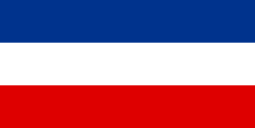Interval signal
An interval signal, or tuning signal, is a characteristic sound or musical phrase used in international broadcasting and by some domestic broadcasters, played before commencement or during breaks in transmission, but most commonly between programmes in different languages. It serves several purposes:
- It assists a listener to tune his or her radio to the correct frequency of the station. This is because most older and cheaper radio receivers do not have digital frequency readout.
- It informs other stations that the frequency is in use.
- It serves as a station identifier even if the language used in the subsequent broadcast is not one the listener understands.
The practice began in Europe in the 1920s and 1930s and was carried over into shortwave broadcasts. The use of interval signals has declined with the advent of digital tuning systems, but has not vanished. Interval signals were not required on commercial channels in the USA, where jingles were used as identification.
Broadcasting services and interval signals
-
 BBC World Service: Bow Bells (English programme), three notes tuned B-B-C (non-English programme, non-Europe), four notes tuned B-B-B-E (non-English programme, to Europe).
BBC World Service: Bow Bells (English programme), three notes tuned B-B-C (non-English programme, non-Europe), four notes tuned B-B-B-E (non-English programme, to Europe). -
 Radiodifusión Argentina al Exterior: First eight notes of Mi Buenos Aires querido by Carlos Gardel.
Radiodifusión Argentina al Exterior: First eight notes of Mi Buenos Aires querido by Carlos Gardel. -
 Radio Australia: Chimes version of Waltzing Matilda (chorus). News signature tune: Majestic Fanfare.
Radio Australia: Chimes version of Waltzing Matilda (chorus). News signature tune: Majestic Fanfare. -
 Ö1: Three notes tuned O-R-F by Werner Pirchner,[1] played on viola.
Ö1: Three notes tuned O-R-F by Werner Pirchner,[1] played on viola. -
 Radio Belarus: Radzima maja darahaja ("My dear Motherland").
Radio Belarus: Radzima maja darahaja ("My dear Motherland"). -
 Radio Canada International: First four notes of O Canada, played on piano or autoharp.
Radio Canada International: First four notes of O Canada, played on piano or autoharp. -
 China National Radio, China Radio International: Chime version of 义勇军进行曲 ("March of the Volunteers").
China National Radio, China Radio International: Chime version of 义勇军进行曲 ("March of the Volunteers"). -
 Voice of the Strait News Radio: Bell version of 三大纪律八项注意 ("Three Rules of Discipline and Eight Points for Attention").
Voice of the Strait News Radio: Bell version of 三大纪律八项注意 ("Three Rules of Discipline and Eight Points for Attention"). -
 Radio Habana Cuba: Melody of the La Marcha del 26 de Julio ("March of the 26th of July").
Radio Habana Cuba: Melody of the La Marcha del 26 de Julio ("March of the 26th of July"). -
 DR P1: Drømte mig en drøm i nat, played on xylophone.[2]
DR P1: Drømte mig en drøm i nat, played on xylophone.[2] -
 Radio France Internationale: Electronic-disco, culminating in the last 8 measures of La Marseillaise.
Radio France Internationale: Electronic-disco, culminating in the last 8 measures of La Marseillaise. -
 Deutsche Welle: Celesta version of Es sucht der Bruder seine Brüder from Fidelio by Ludwig van Beethoven.
Deutsche Welle: Celesta version of Es sucht der Bruder seine Brüder from Fidelio by Ludwig van Beethoven. -
 Voice of Greece: The Tsopanakos (Little Shepherd), played on floghera. [3]
Voice of Greece: The Tsopanakos (Little Shepherd), played on floghera. [3] -
 All India Radio: A tune composed by Walter Kaufmann or Thakur Balwant Singh, used since 1936.[4]
All India Radio: A tune composed by Walter Kaufmann or Thakur Balwant Singh, used since 1936.[4] -
 Radio Republik Indonesia: Rayuan Pulau Kelapa ("Solace on Coconut Island"), composed by Ismail Marzuki.
Radio Republik Indonesia: Rayuan Pulau Kelapa ("Solace on Coconut Island"), composed by Ismail Marzuki. -
 Radio Japan:
Radio Japan:
Kazoe-uta (Japanese counting song)
さくら さくら ("Sakura Sakura" - Cherry Blossoms).
-
 Voice of Korea: Melody of 김일성장군의 노래 ("Song of General Kim Il-sung").
Voice of Korea: Melody of 김일성장군의 노래 ("Song of General Kim Il-sung"). -
 Pyongyang FM - Melody of 김정일장군의 노래 ("Song of General Kim Jong-il")
Pyongyang FM - Melody of 김정일장군의 노래 ("Song of General Kim Jong-il") -
 KBS World Radio: Dawn.
KBS World Radio: Dawn. -
 RTL Radio: Feierwon by Michel Lentz, played on chimes.[5]
RTL Radio: Feierwon by Michel Lentz, played on chimes.[5] -
 Voice of Mongolia: Эх орон ("Motherland").
Voice of Mongolia: Эх орон ("Motherland"). -
 Radio Netherlands: Carillon version of the Eighty Years' War song Merck toch hoe sterck.
Radio Netherlands: Carillon version of the Eighty Years' War song Merck toch hoe sterck. -
 Radio New Zealand International: The call of a New Zealand bellbird.
Radio New Zealand International: The call of a New Zealand bellbird. -
 Radio Pakistan:
Radio Pakistan: -
 Far East Broadcasting Company: Lord Jesus to Save Sinners.
Far East Broadcasting Company: Lord Jesus to Save Sinners. -
 Polish Radio External Service: Excerpt from Prząśniczka by Stanisław Moniuszko, played on piano.[6]
Polish Radio External Service: Excerpt from Prząśniczka by Stanisław Moniuszko, played on piano.[6] -
 RTÉ Radio 1: Chime version of O'Donnell Abú ("O'Donnell Forever").[7]
RTÉ Radio 1: Chime version of O'Donnell Abú ("O'Donnell Forever").[7] -
 Radio Romania International: Pui de lei.
Radio Romania International: Pui de lei. -
 Radio Slovenia: Electronically generated cuckoo chirping.
Radio Slovenia: Electronically generated cuckoo chirping. -
 Radio Sweden: Chime version of Ut i vida världen ("Out in the Wide World"), composed by Ralph Lundsten.[8]
Radio Sweden: Chime version of Ut i vida världen ("Out in the Wide World"), composed by Ralph Lundsten.[8] -
 Radio Tirana: Këputa një gjethe dafine (transmission intro).
Radio Tirana: Këputa një gjethe dafine (transmission intro). -
 Radio Ukraine International: Reve ta stohne Dnipr shyrokyi.
Radio Ukraine International: Reve ta stohne Dnipr shyrokyi. -
 Trans World Radio: What a Friend We Have in Jesus.
Trans World Radio: What a Friend We Have in Jesus. -
 Voice of America: Brass band version of Yankee Doodle.
Voice of America: Brass band version of Yankee Doodle. -
 Vatican Radio: Christus Vincit, played on celesta.
Vatican Radio: Christus Vincit, played on celesta. -
 Radio Nacional de Venezuela - Canal Internacional: Beginning of Alma Llanera by Pedro Elías Gutiérrez and Rafael Bolívar.
Radio Nacional de Venezuela - Canal Internacional: Beginning of Alma Llanera by Pedro Elías Gutiérrez and Rafael Bolívar.
Formerly used
-
 BBC World Service: Trumpet version of Oranges and Lemons, first four notes of Symphony No. 5 by Beethoven, played on timpani; Lillibullero (signature tune, played on trumpet).[9]
BBC World Service: Trumpet version of Oranges and Lemons, first four notes of Symphony No. 5 by Beethoven, played on timpani; Lillibullero (signature tune, played on trumpet).[9] -
 Radio Tirana: Trumpet version of With Pickaxe and Rifle.
Radio Tirana: Trumpet version of With Pickaxe and Rifle. -
 Radio Austria International: Orchestral version of An der schönen blauen Donau ("Blue Danube Waltz") by Johann Strauss.[10]
Radio Austria International: Orchestral version of An der schönen blauen Donau ("Blue Danube Waltz") by Johann Strauss.[10] -
.svg.png) RTBF International: Où peut-on être mieux qu’au sein de sa famille.
RTBF International: Où peut-on être mieux qu’au sein de sa famille. -
 Rádio Nacional: Luar do Sertão.
Rádio Nacional: Luar do Sertão. -
 Radio Peking (predecessor of China Radio International): Chimes version of 东方红 ("The East Is Red").
Radio Peking (predecessor of China Radio International): Chimes version of 东方红 ("The East Is Red"). -
 Radio Prague:
Radio Prague:
Trumpet version of Kupředu levá ("Forward, Left") by Jan Seidl
Adagio – Allegro molto from Symphony No. 9 by Dvořák. -
 Radio Finland: Pim-pam-pulla by A. O. Väisänen.[11]
Radio Finland: Pim-pam-pulla by A. O. Väisänen.[11] -
 Radio France Internationale: Trumpet version of a popular song Nous n'irons plus au bois.[10]
Radio France Internationale: Trumpet version of a popular song Nous n'irons plus au bois.[10] -
 Berliner Rundfunk: Motif from the opera Regina by Albert Lortzing, played by trumpets.
Berliner Rundfunk: Motif from the opera Regina by Albert Lortzing, played by trumpets. -
 Radio Berlin International: Beginning of Auferstanden aus Ruinen ("Risen from Ruins"), played on chimes.
Radio Berlin International: Beginning of Auferstanden aus Ruinen ("Risen from Ruins"), played on chimes. -
 Radio DDR: First few bars of Wann wir schreiten Seit’ an Seit’.
Radio DDR: First few bars of Wann wir schreiten Seit’ an Seit’. -
 Deutschlandfunk: Celesta version of Dir, Land voll Lieb' und Leben from "Ich hab mich ergeben" by Hans Ferdinand Maßmann.[12]
Deutschlandfunk: Celesta version of Dir, Land voll Lieb' und Leben from "Ich hab mich ergeben" by Hans Ferdinand Maßmann.[12] -
 Radio Budapest: Excerpts from the suite 1848 by T.K. Polgar played on 3 trumpets and 2 cornets.
Radio Budapest: Excerpts from the suite 1848 by T.K. Polgar played on 3 trumpets and 2 cornets. -
 Kol Yisrael: Trumpet and drum version of Hatikvah.
Kol Yisrael: Trumpet and drum version of Hatikvah. -
 Rai Italia Radio: Mechanically generated canary chirping.
Rai Italia Radio: Mechanically generated canary chirping. -
 Trans World Radio: Hymne Monégasque
Trans World Radio: Hymne Monégasque -
 NPO: First seven notes of Wilhelmus, played on clarinet (Radio 1 and Radio 5), synthesizer (Radio 3), spinet (Radio 4) and carillon (Radio 2).[13]
NPO: First seven notes of Wilhelmus, played on clarinet (Radio 1 and Radio 5), synthesizer (Radio 3), spinet (Radio 4) and carillon (Radio 2).[13] -
 NRK P1: Motif from Sigurd Josarfal by Edward Grieg.[14]
NRK P1: Motif from Sigurd Josarfal by Edward Grieg.[14] -
 Radio Norway International (former international service of NRK): Ancient folk tune from the Hallingdal region[15] and
Radio Norway International (former international service of NRK): Ancient folk tune from the Hallingdal region[15] and -
 Radio Katowice: Sound of a hammer striking an anvil.[16]
Radio Katowice: Sound of a hammer striking an anvil.[16] -
 Radio Polonia: Piano version of Etude No. 12 ("Revolutionary Etude") by Frédéric Chopin.
Radio Polonia: Piano version of Etude No. 12 ("Revolutionary Etude") by Frédéric Chopin. -
 Radio Mayak: Vibraphone version of Moscow Nights.
Radio Mayak: Vibraphone version of Moscow Nights. -
 Voice of Russia: "Majestic" chorus from the "Great Gate of Kiev" portion of Pictures at an Exhibition by Mussorgsky.
Voice of Russia: "Majestic" chorus from the "Great Gate of Kiev" portion of Pictures at an Exhibition by Mussorgsky. -
 Radio Serbia: Bože pravde.
Radio Serbia: Bože pravde. -
 Radio Slovakia International: Kto za pravdu horí.
Radio Slovakia International: Kto za pravdu horí. -
 Radio RSA (former international service of Apartheid-era South African Broadcasting Corporation): Bokmakierie chirping and first bars of Ver in die Wereld, Kittie, played on guitar.[10][17]
Radio RSA (former international service of Apartheid-era South African Broadcasting Corporation): Bokmakierie chirping and first bars of Ver in die Wereld, Kittie, played on guitar.[10][17] -
 Radio Sweden: Opening notes of Carl Michael Bellman's Storm och böljor tystna r'en.[10]
Radio Sweden: Opening notes of Carl Michael Bellman's Storm och böljor tystna r'en.[10] -
 Radio Beromünster: D' Zit isch do, played on music box.
Radio Beromünster: D' Zit isch do, played on music box. -
 Swiss Radio International: Lueget, vo Berg und Tal.
Swiss Radio International: Lueget, vo Berg und Tal. -
 Voice of Turkey: Makam, played on piano.
Voice of Turkey: Makam, played on piano. -
 Radio Moscow (former international service of the Soviet Union):
Radio Moscow (former international service of the Soviet Union):
Песня о Родине ("Wide Is My Motherland")
Midnight in Moscow, played by balalaika. -

 Radio Yugoslavia, later International Radio of Serbia and Montenegro: Jugoslavijo by Nikola Hercigonja.
Radio Yugoslavia, later International Radio of Serbia and Montenegro: Jugoslavijo by Nikola Hercigonja.
Numbers stations interval signals
Numbers stations are often named after their interval signals, such as The Lincolnshire Poacher or Magnetic Fields after "Magnetic Fields Part 1" by Jean-Michel Jarre.
References
- ↑ Ö1 gehört gehört, p. 218.
- ↑ https://www.youtube.com/watch?v=lpDQYdoIQ0w
- ↑ https://www.youtube.com/watch?v=Q_jNvmGDqwk
- ↑ Tuning into broadcast history. The Hindu BusinessLine, 15 October 2015.
- ↑ http://www.radioforen.de/index.php?threads/pausenzeichen-und-ihre-musikalischen-quellen.21902/page-3
- ↑ https://www.youtube.com/watch?v=ztH0_2ueIYc
- ↑
- ↑ Radio Sweden interval signal Retrieved 2011-11-24.
- ↑ BBC World Service (Europe) interval signal Retrieved 2013-10-09.
- 1 2 3 4 Frost, J. M. World Radio TV Handbook. New York: Billboard Publications, 1983.
- ↑ yle.fi
- ↑ http://www.kalter-krieg-im-radio.de/index.php?er=18#
- ↑ nl:Pauzeteken
- ↑ http://www.ontheshortwaves.com/Articles/The_Interval_Signal.pdf
- ↑ Frost, Jens Mathiesen. World Radio-TV Handbook. London: Billboard Publications, 1974.
- ↑ Youtube
- ↑ DX LISTENING DIGEST 7-043
Frost, Jens Mathiesen (1974). World Radio-TV Handbook 1974. London: Billboard Publications. p. 408. ISBN 0823058980.
Sennitt, Andrew G.; David Bobbitt (December 2005). World Radio and Television Handbook 2006. Billboard Books. p. 608. ISBN 0-8230-7798-5.
Sennitt, Andrew G. World Radio and Television Handbook 1997. Billboard Books. p. 560. ISBN 0-8230-7797-7.
External links
- Interval Signals Online
- Nobuyuki Kawamura's Interval Signal Library
- IntervalSignal DataBase (German) English version
- Uwe Volk's Sound Library (available both in English and in German)
- Kurzwelle-Historisch
- Interval signals on Live-Radio.net